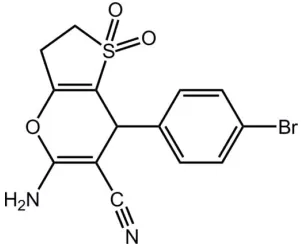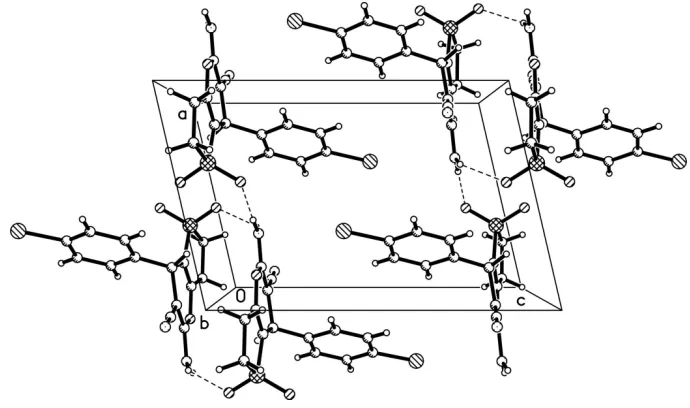5-Amino-7-(4-bromophenyl)-3,7-di-hydro-2
H
-thieno[3,2-
b
]pyran-6-carbo-nitrile 1,1-dioxide
Chen-Xia Yu, Xiao-Dong Feng, Bei Jiang, Cui-Hua Wang and Chang-Sheng Yao*
School of Chemistry and Chemical Engineering, Xuzhou Normal University, Xuzhou 221116, People’s Republic of China, and, Key Laboratory of Biotechnology for Medicinal Plants, Xuzhou Normal University, Xuzhou 221116, People’s Republic of China
Correspondence e-mail: chshengyaonk@mail.nankai.edu.cn Received 16 November 2009; accepted 23 December 2009
Key indicators: single-crystal X-ray study;T= 113 K; mean(C–C) = 0.003 A˚;
Rfactor = 0.036;wRfactor = 0.088; data-to-parameter ratio = 17.4.
In the title compound, C14H11BrN2O3S, the
2,3-dihydrothio-phene ring is almost planar [maximum deviation = 0.006 (1) A˚ ]. The pyran ring is in an envelope conformation [puckering parameters Q = 0.115 (2) A˚ , = 77.5 (10), ’ = 172.9 (10)]. The pyran and phenyl rings are approximately perpendicular, making a dihedral angle of 76.4 (2). The crystal packing is stabilized by intermolecular N—H O hydrogen bonds, with the sulfone O atoms acting as acceptors.
Related literature
For the use of thienopyranyl compounds, such as
thieno[3,2-b]pyran derivatives, as antiviral agents, see: Friaryet al.(1991) and as-2C adrenoreceptor agonists, see: Chaoet al.(2009). For puckering parameters, see: Cremer & Pople (1975).
Experimental
Crystal data
C14H11BrN2O3S
Mr= 367.22
Monoclinic,P21=c
a= 8.3743 (18) A˚ b= 14.003 (3) A˚ c= 12.673 (3) A˚
= 103.059 (3)
V= 1447.7 (5) A˚3
Z= 4
MoKradiation
= 2.99 mm1
T= 113 K
0.240.220.12 mm
Data collection
Rigaku Saturn CCD area-detector diffractometer
Absorption correction: multi-scan (CrystalClear; Rigaku/MSC, 2005)
Tmin= 0.534,Tmax= 0.715
14473 measured reflections 3440 independent reflections 2636 reflections withI> 2(I) Rint= 0.038
Refinement
R[F2> 2(F2)] = 0.036
wR(F2) = 0.088
S= 0.99 3440 reflections 198 parameters
H atoms treated by a mixture of independent and constrained refinement
max= 0.43 e A˚3
[image:1.610.95.248.544.666.2]min=0.95 e A˚3
Table 1
Hydrogen-bond geometry (A˚ ,).
D—H A D—H H A D A D—H A N2—H1 O2i
0.88 (3) 2.26 (3) 2.989 (3) 140 (2) N2—H2 O3ii
0.91 (3) 2.02 (3) 2.919 (3) 169 (2)
Symmetry codes: (i)xþ2;yþ2;zþ1; (ii)xþ1;y;z.
Data collection:CrystalClear(Rigaku/MSC, 2005); cell refinement: CrystalClear; data reduction:CrystalClear; program(s) used to solve structure:SHELXS97(Sheldrick, 2008); program(s) used to refine structure: SHELXL97 (Sheldrick, 2008); molecular graphics: SHELXTL(Sheldrick, 2008); software used to prepare material for publication:SHELXTL.
The authors acknowledge financial support by the Graduate Foundation of Xuzhou Normal University (No. 09YLB030).
Supplementary data and figures for this paper are available from the IUCr electronic archives (Reference: FJ2262).
References
Chao, J. H., Zheng, J. Y. & Aslanian, R. G. (2009). WO Patent No. 2009020578. Cremer, D. & Pople, J. A. (1975).J. Am. Chem. Soc.97, 1354–1358. Friary, R. J., Schwerdt, J. H. & Ganguly, A. K. (1991). US Patent No. 5034531. Rigaku/MSC (2005).CrystalClear. Rigaku/MSC Inc., The Woodlands, Texas,
USA.
Sheldrick, G. M. (2008).Acta Cryst.A64, 112–122.
Acta Crystallographica Section E
Structure Reports
Online
supporting information
Acta Cryst. (2010). E66, o264 [https://doi.org/10.1107/S1600536809055214]
5-Amino-7-(4-bromophenyl)-3,7-dihydro-2
H
-thieno[3,2-
b
]pyran-6-carbonitrile
1,1-dioxide
Chen-Xia Yu, Xiao-Dong Feng, Bei Jiang, Cui-Hua Wang and Chang-Sheng Yao
S1. Comment
Thienopyranyl compounds, such as thieno [3,2-b]pyran derivatives, can be used as antiviral agents (Friary et al., 1991) and α-2 C adrenoreceptor agonists (Chao et al., 2009). This led us to pay much attention to the synthesis and bioactivity of these compounds. During the synthesis of thieno[3,2-b]pyran derivatives, the title compound, (I) was isolated and its structure was determined by X-ray diffraction. Here we shall report its crystal structure.
The molecular structure of (I) is shown in Fig. 1. In the molecular structure, the thiophene ring is in planar
conformation, for the maximum deviation of C6 from the C4/C5/C6/C7/S1 plane is 0.006 (1) Å. For its weighted average
ABS. torsion Angl. is 0.60°, less than 5.0°, Cremer & Pople puckering analysis was not performed(Cremer & Pople, 1975). The pyran ring adopts an envelope conformation with atome C3 deviating from the O1/C1/C2/C4/C5 plane
0.158 (3) Å. According to Cremer & Pople analysis, the puckering amplitude (Q) is 0.115 (2) Å. Its θ and φ are 77.5 (10) and 172.9 (10)°, respectively. The connection of the pyran ring and phenyl ring C8—C13 can be described by the C2—
C3—C8—C13 torsion angle of -76.4 (2)°. The crystal packing is stablized intermolecular hydrogen bonds: N2—H1···O2,
N2—H2···O3(Fig.2 & Table 1).
S2. Experimental
The title compound was synthesized by the reaction of dihydrothiophen-3(2H)-one-1,1-dioxide (1 mmol) and 2-(4-bromo benzylidene)malononitrile (1 mmol) catalyzed by triethylamine (0.02 g) in 10 ml ethanol under reluxing until completion
(monitored by TLC). Cooling the reaction mixture slowly gave single crystals suitable for X-ray diffraction.
S3. Refinement
The H atoms bonded to the amide N atom was located in a difference map and were refined freely. Other H atoms were
placed in calculated positions, with C—H = 0.95 or 0.99 Å, and included in the final cycles of refinement using a riding
Figure 1
The structure of (I), showing 30% probability displacement ellipsoids and the atom-numbering scheme.
Figure 2
The packing diagram of (I). Intermolecular hydrogen bonds are shown as dashed lines.
5-Amino-7-(4-bromophenyl)-3,7-dihydro-2H- thieno[3,2-b]pyran-6-carbonitrile 1,1-dioxide
Crystal data
C14H11BrN2O3S
Mr = 367.22
Monoclinic, P21/c a = 8.3743 (18) Å
b = 14.003 (3) Å
c = 12.673 (3) Å
β = 103.059 (3)°
V = 1447.7 (5) Å3
Z = 4
F(000) = 736
Dx = 1.685 Mg m−3
Mo Kα radiation, λ = 0.71070 Å Cell parameters from 4061 reflections
[image:3.610.131.476.348.552.2]µ = 2.99 mm−1
T = 113 K
Block, colorless 0.24 × 0.22 × 0.12 mm
Data collection
Rigaku Saturn CCD area-detector diffractometer
Radiation source: rotating anode Confocal monochromator
Detector resolution: 7.31 pixels mm-1
ω and φ scans
Absorption correction: multi-scan (CrystalClear; Rigaku/MSC, 2005)
Tmin = 0.534, Tmax = 0.715
14473 measured reflections 3440 independent reflections 2636 reflections with I > 2σ(I)
Rint = 0.038
θmax = 27.9°, θmin = 2.2°
h = −10→10
k = −18→18
l = −16→16
Refinement
Refinement on F2 Least-squares matrix: full
R[F2 > 2σ(F2)] = 0.036
wR(F2) = 0.088
S = 0.99 3440 reflections 198 parameters 0 restraints
Primary atom site location: structure-invariant direct methods
Secondary atom site location: difference Fourier map
Hydrogen site location: inferred from neighbouring sites
H atoms treated by a mixture of independent and constrained refinement
w = 1/[σ2(F
o2) + (0.053P)2] where P = (Fo2 + 2Fc2)/3 (Δ/σ)max = 0.002
Δρmax = 0.43 e Å−3 Δρmin = −0.95 e Å−3
Special details
Geometry. All e.s.d.'s (except the e.s.d. in the dihedral angle between two l.s. planes) are estimated using the full covariance matrix. The cell e.s.d.'s are taken into account individually in the estimation of e.s.d.'s in distances, angles and torsion angles; correlations between e.s.d.'s in cell parameters are only used when they are defined by crystal symmetry. An approximate (isotropic) treatment of cell e.s.d.'s is used for estimating e.s.d.'s involving l.s. planes.
Refinement. Refinement of F2 against ALL reflections. The weighted R-factor wR and goodness of fit S are based on F2, conventional R-factors R are based on F, with F set to zero for negative F2. The threshold expression of F2 > σ(F2) is used only for calculating R-factors(gt) etc. and is not relevant to the choice of reflections for refinement. R-factors based on F2 are statistically about twice as large as those based on F, and R- factors based on ALL data will be even larger.
Fractional atomic coordinates and isotropic or equivalent isotropic displacement parameters (Å2)
x y z Uiso*/Ueq
Br1 0.66967 (3) 1.11722 (2) 1.066878 (18) 0.03931 (11)
S1 0.65228 (6) 0.83655 (4) 0.56887 (4) 0.01756 (13)
O1 1.12195 (16) 0.86398 (10) 0.63555 (11) 0.0190 (3)
O2 0.56187 (19) 0.87395 (11) 0.46675 (13) 0.0269 (4)
O3 0.56402 (17) 0.83246 (11) 0.65464 (12) 0.0248 (4)
N1 1.1137 (2) 1.20266 (14) 0.67001 (15) 0.0277 (4)
N2 1.3147 (2) 0.97623 (16) 0.66289 (15) 0.0231 (4)
C1 1.1535 (2) 0.95981 (16) 0.64815 (15) 0.0181 (4)
C2 1.0334 (2) 1.02597 (15) 0.64622 (15) 0.0164 (4)
C3 0.8526 (2) 1.00119 (14) 0.63725 (15) 0.0161 (4)
H3 0.7842 1.0381 0.5758 0.019*
C5 0.9603 (2) 0.83720 (15) 0.61122 (15) 0.0158 (4)
C6 0.9284 (2) 0.73518 (15) 0.58117 (16) 0.0187 (4)
H6A 0.9776 0.6932 0.6429 0.022*
H6B 0.9761 0.7185 0.5189 0.022*
C7 0.7412 (2) 0.72300 (15) 0.55110 (18) 0.0237 (5)
H7A 0.7068 0.6746 0.5984 0.028*
H7B 0.7050 0.7017 0.4750 0.028*
C8 0.7996 (2) 1.02716 (15) 0.74159 (15) 0.0165 (4)
C9 0.7130 (2) 1.11041 (14) 0.74657 (17) 0.0189 (4)
H9 0.6812 1.1491 0.6838 0.023*
C10 0.6716 (3) 1.13834 (17) 0.84266 (17) 0.0229 (5)
H10 0.6122 1.1957 0.8460 0.027*
C11 0.7190 (2) 1.08054 (17) 0.93298 (16) 0.0217 (5)
C12 0.8041 (3) 0.99677 (16) 0.92947 (16) 0.0227 (5)
H12 0.8346 0.9579 0.9922 0.027*
C13 0.8450 (2) 0.96971 (15) 0.83348 (16) 0.0206 (5)
H13 0.9037 0.9121 0.8304 0.025*
C15 1.0788 (3) 1.12338 (16) 0.65907 (16) 0.0186 (4)
H1 1.349 (3) 1.035 (2) 0.655 (2) 0.038 (7)*
H2 1.382 (3) 0.925 (2) 0.659 (2) 0.038 (7)*
Atomic displacement parameters (Å2)
U11 U22 U33 U12 U13 U23
Geometric parameters (Å, º)
Br1—C11 1.905 (2) C4—C5 1.324 (3)
S1—O2 1.4421 (16) C5—C6 1.487 (3)
S1—O3 1.4470 (15) C6—C7 1.537 (3)
S1—C4 1.742 (2) C6—H6A 0.9900
S1—C7 1.791 (2) C6—H6B 0.9900
O1—C1 1.370 (3) C7—H7A 0.9900
O1—C5 1.371 (2) C7—H7B 0.9900
N1—C15 1.148 (3) C8—C9 1.382 (3)
N2—C1 1.340 (3) C8—C13 1.396 (3)
N2—H1 0.88 (3) C9—C10 1.395 (3)
N2—H2 0.91 (3) C9—H9 0.9500
C1—C2 1.364 (3) C10—C11 1.385 (3)
C2—C15 1.416 (3) C10—H10 0.9500
C2—C3 1.532 (3) C11—C12 1.379 (3)
C3—C4 1.496 (3) C12—C13 1.389 (3)
C3—C8 1.531 (3) C12—H12 0.9500
C3—H3 1.0000 C13—H13 0.9500
O2—S1—O3 115.77 (10) C7—C6—H6A 110.4
O2—S1—C4 110.20 (10) C5—C6—H6B 110.4
O3—S1—C4 111.35 (9) C7—C6—H6B 110.4
O2—S1—C7 111.00 (10) H6A—C6—H6B 108.6
O3—S1—C7 110.89 (10) C6—C7—S1 107.46 (14)
C4—S1—C7 95.89 (9) C6—C7—H7A 110.2
C1—O1—C5 116.68 (16) S1—C7—H7A 110.2
C1—N2—H1 119.2 (17) C6—C7—H7B 110.2
C1—N2—H2 117.9 (17) S1—C7—H7B 110.2
H1—N2—H2 120 (2) H7A—C7—H7B 108.5
N2—C1—C2 127.0 (2) C9—C8—C13 119.66 (18)
N2—C1—O1 110.25 (18) C9—C8—C3 119.83 (18)
C2—C1—O1 122.75 (18) C13—C8—C3 120.44 (18)
C1—C2—C15 118.32 (18) C8—C9—C10 120.9 (2)
C1—C2—C3 124.07 (19) C8—C9—H9 119.6
C15—C2—C3 117.53 (17) C10—C9—H9 119.6
C4—C3—C8 113.76 (16) C11—C10—C9 118.4 (2)
C4—C3—C2 105.54 (16) C11—C10—H10 120.8
C8—C3—C2 110.88 (15) C9—C10—H10 120.8
C4—C3—H3 108.8 C12—C11—C10 121.63 (19)
C8—C3—H3 108.8 C12—C11—Br1 118.42 (16)
C2—C3—H3 108.8 C10—C11—Br1 119.95 (17)
C5—C4—C3 126.21 (19) C11—C12—C13 119.48 (19)
C5—C4—S1 109.30 (16) C11—C12—H12 120.3
C3—C4—S1 124.47 (15) C13—C12—H12 120.3
C4—C5—O1 123.58 (19) C12—C13—C8 119.9 (2)
C4—C5—C6 120.83 (18) C12—C13—H13 120.0
C5—C6—C7 106.51 (16) N1—C15—C2 179.0 (2)
C5—C6—H6A 110.4
C5—O1—C1—N2 −175.02 (16) C1—O1—C5—C4 −7.0 (3)
C5—O1—C1—C2 5.5 (3) C1—O1—C5—C6 170.86 (16)
N2—C1—C2—C15 1.2 (3) C4—C5—C6—C7 1.2 (3)
O1—C1—C2—C15 −179.45 (17) O1—C5—C6—C7 −176.74 (16)
N2—C1—C2—C3 −175.30 (19) C5—C6—C7—S1 −0.9 (2)
O1—C1—C2—C3 4.1 (3) O2—S1—C7—C6 114.83 (15)
C1—C2—C3—C4 −10.6 (2) O3—S1—C7—C6 −115.01 (14)
C15—C2—C3—C4 172.93 (17) C4—S1—C7—C6 0.54 (16)
C1—C2—C3—C8 113.0 (2) C4—C3—C8—C9 −140.68 (18)
C15—C2—C3—C8 −63.5 (2) C2—C3—C8—C9 100.6 (2)
C8—C3—C4—C5 −112.4 (2) C4—C3—C8—C13 42.4 (2)
C2—C3—C4—C5 9.4 (3) C2—C3—C8—C13 −76.4 (2)
C8—C3—C4—S1 69.5 (2) C13—C8—C9—C10 0.6 (3)
C2—C3—C4—S1 −168.70 (14) C3—C8—C9—C10 −176.30 (18)
O2—S1—C4—C5 −114.85 (15) C8—C9—C10—C11 −0.1 (3)
O3—S1—C4—C5 115.27 (15) C9—C10—C11—C12 −0.5 (3)
C7—S1—C4—C5 0.10 (17) C9—C10—C11—Br1 178.53 (15)
O2—S1—C4—C3 63.5 (2) C10—C11—C12—C13 0.6 (3)
O3—S1—C4—C3 −66.35 (19) Br1—C11—C12—C13 −178.44 (16)
C7—S1—C4—C3 178.48 (17) C11—C12—C13—C8 −0.1 (3)
C3—C4—C5—O1 −1.4 (3) C9—C8—C13—C12 −0.5 (3)
S1—C4—C5—O1 176.96 (14) C3—C8—C13—C12 176.40 (18)
C3—C4—C5—C6 −179.15 (18) C1—C2—C15—N1 −156 (15)
S1—C4—C5—C6 −0.8 (2) C3—C2—C15—N1 21 (15)
Hydrogen-bond geometry (Å, º)
D—H···A D—H H···A D···A D—H···A
N2—H1···O2i 0.88 (3) 2.26 (3) 2.989 (3) 140 (2)
N2—H2···O3ii 0.91 (3) 2.02 (3) 2.919 (3) 169 (2)

